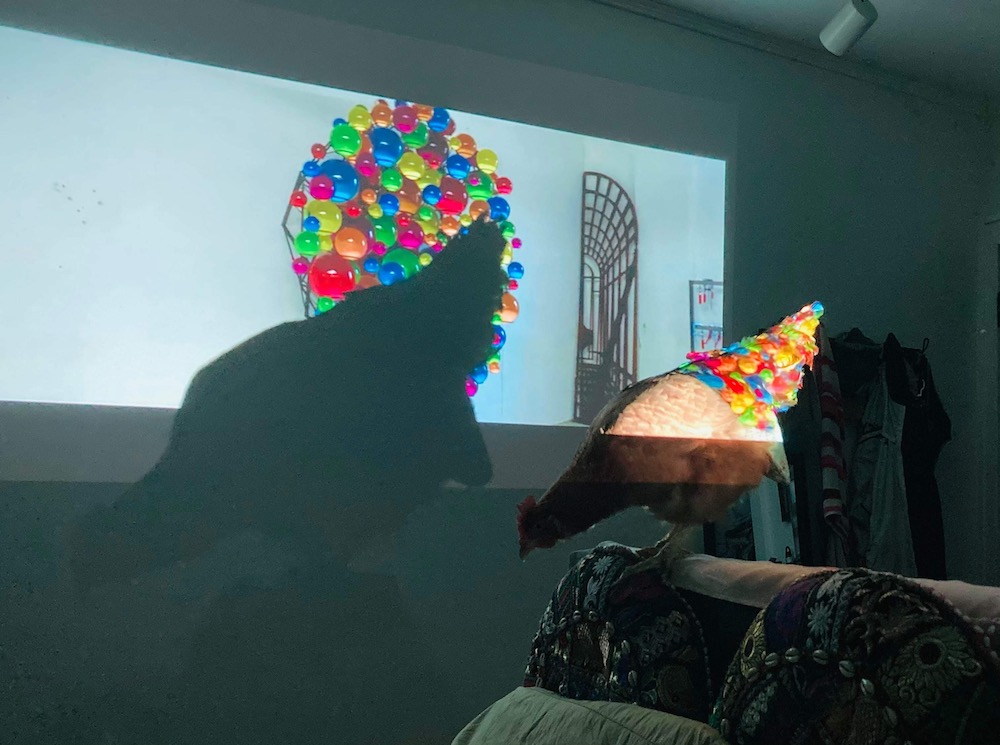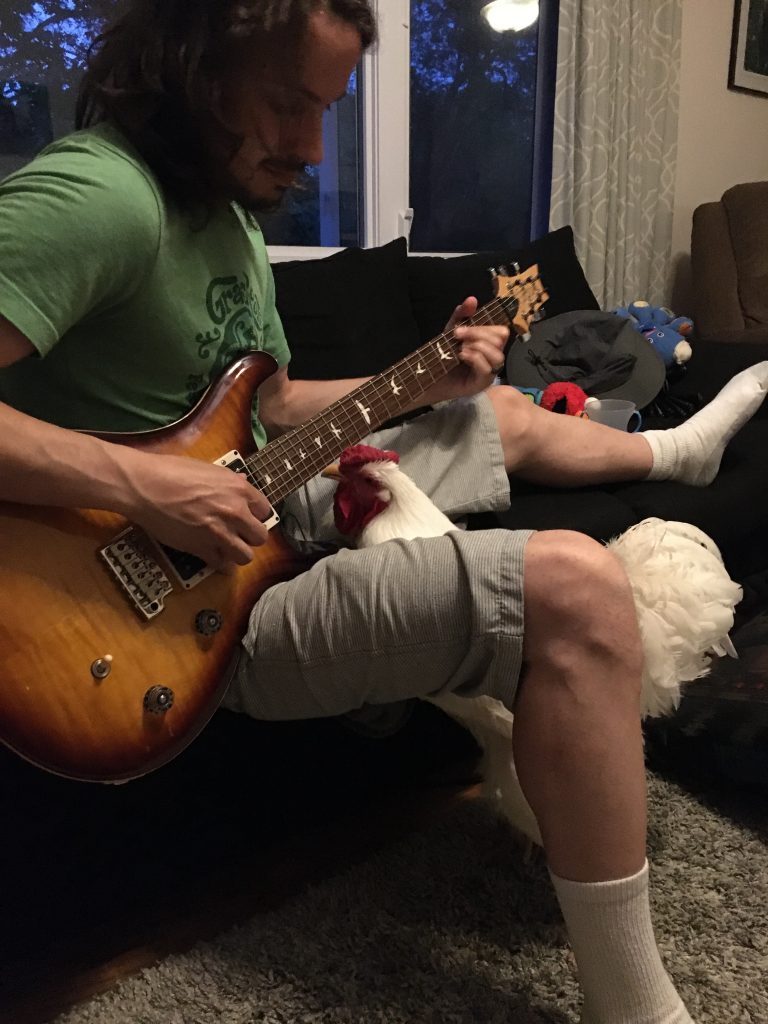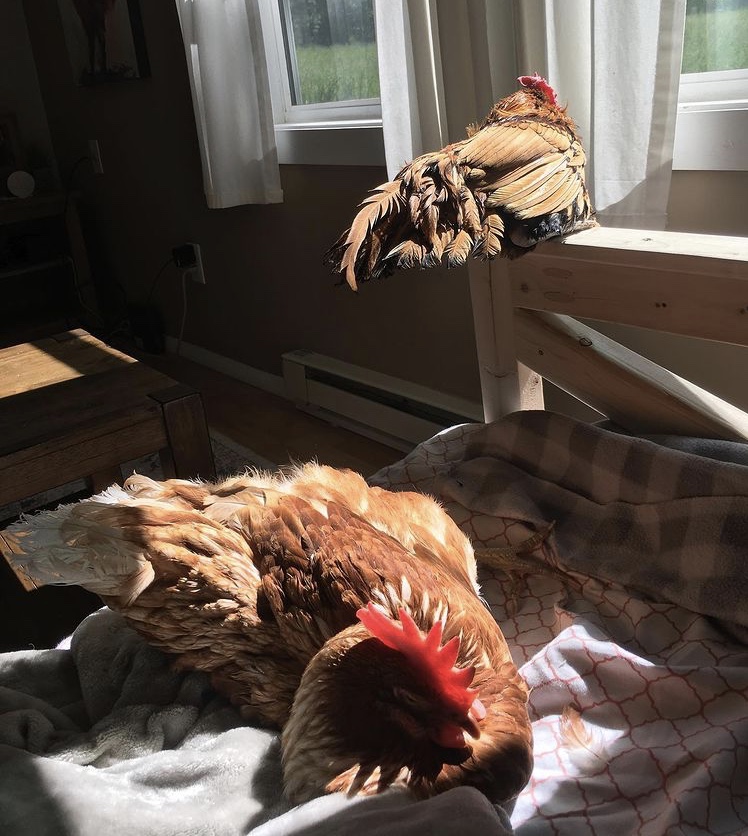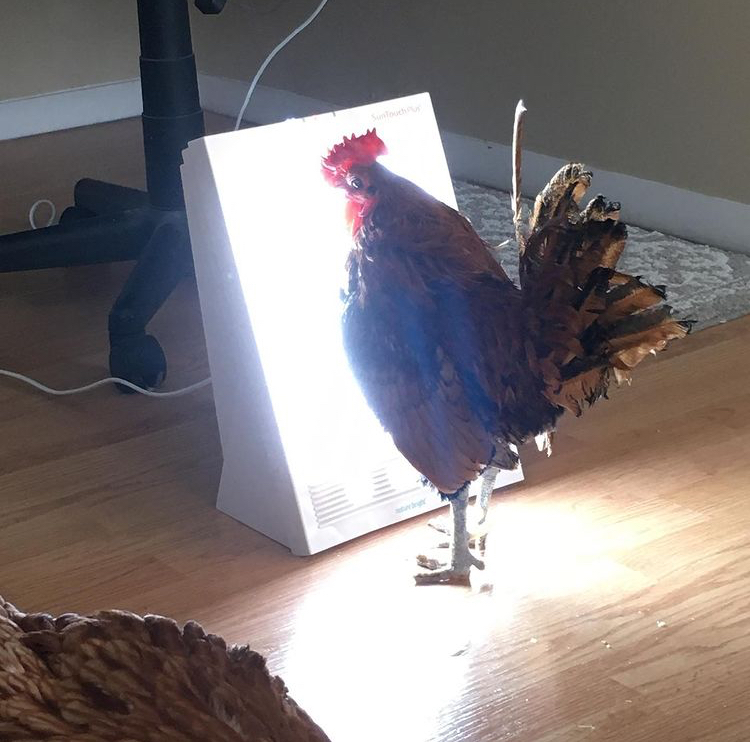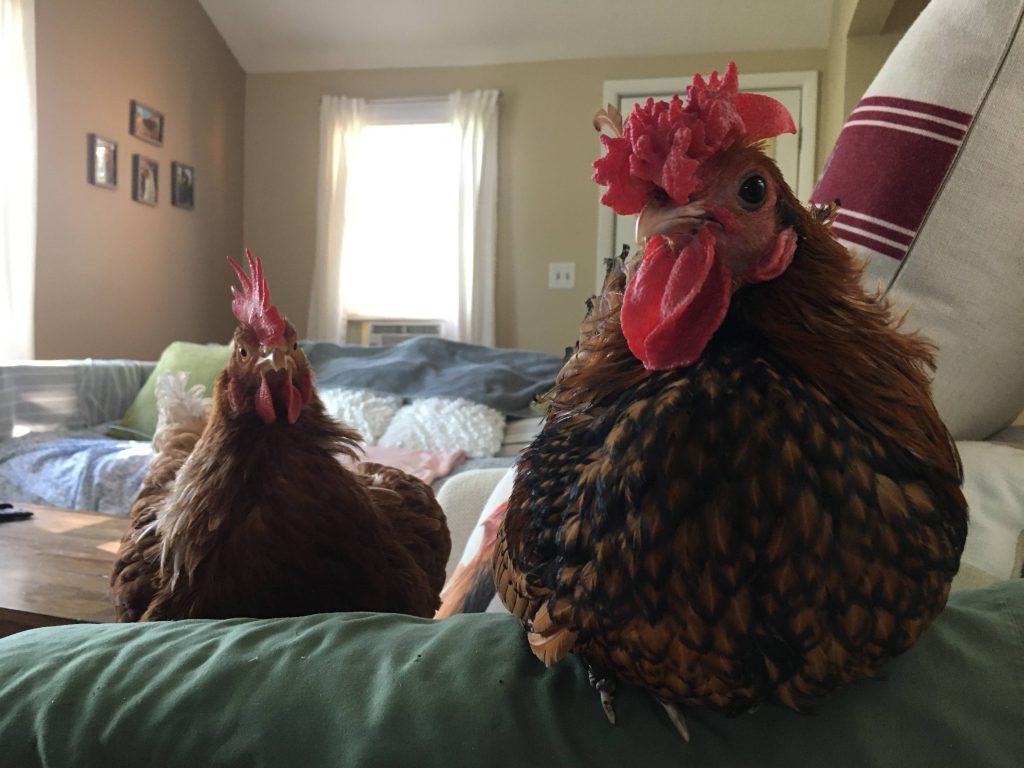

We have Podcast Episodes About This Topic!
Looking for more perspective about this resource? We’ve recorded two podcast episodes about it! Check out Indoor Chickens Part 1 here and Indoor Chickens Part 2 here!
Updated September 28, 2021
Did you know chickens can do quite well living alongside their caregiver(s) in a house or apartment? More and more compassionate caregivers are caring for companion chickens inside their own home rather than setting up a separate structure, such as a coop, barn, or shed. While it may sound strange to someone who has only pictured chickens living outdoors, it’s really only strange because most of us have grown up in a society that says some bird species are food (or produce food) and, therefore, belong outside, while some other bird species, such as parrots (who ideally should be living in the wild), are companion animalsAnimals who spend regular time with humans in their home and life. Typically cats and dogs are considered companion animals, though many species of animals could also be companion animals. who belong in our homes.
Of course, there’s a bit more to caring for “house chickens” than just bringing your chicken residents inside. Before we talk about how to safely care for chickens in your home, let’s talk about why this option is becoming more popular and the benefits that come along with it.
Indoors Or Out, There’s Lots To Know About Compassionate Chicken Care!
In this resource, we are going to focus on how to safely care for chicken companions in your home. However, there is so much more to responsible chicken care than just housing arrangements. Before you welcome a chicken into your life, it’s important to learn about their needs and how to care for them properly. For more information on compassionate chicken care, head over to our Compassionate Care Classroom and check out our Basic Chicken Care courses.
Benefits That Come With The Home Care Setting
There are numerous benefits that come with the home caregiving model. First, we’ll look at the benefits to the individual chickens living in these settings, and then we’ll discuss some of the additional benefits that come with this model.
“Coops”
To keep things simple, we’re going to use the term “coop” to refer to any chicken structure that is separate from the caregiver’s home.
Protection From The Elements

In some climates, it may be very difficult to keep chicken residents safe and comfortable in a coop. During cold weather, chickens need a living space that can keep them warm, while still providing adequate ventilation to prevent respiratory illnesses and frostbite. In some regions, coops will require a heat source. While some heat sources are safer than others, any heat source that requires power carries some fire risk. Chickens living in a home setting get to enjoy the same ambient temperatures and insulated structures as their caregivers. Even if they spend time in colder areas of your home and you feel a supplemental heat source is necessary, due to the inherent differences between a human dwelling and a chicken coop, you’ll likely be able to provide this without the same degree of risk as in a coop. The differences in electrical infrastructure available to a human dwelling that is up to code, versus what can be provided in an outdoor coop, as well as other key differences (think of all the flammable bedding and dust in a coop) result in a lower degree of fire risk in a home. Not to mention that a fire in a coop that occurs overnight when humans are sleeping could go undetected until it is too late. That being said, please note that glass bulb heat lamps carry significant fire risks regardless of whether they are indoors or out when it comes to our feathered friends. In addition to the many risks that come with using these heat lamps in a coop or indoors, dust and feathers carry significant fire risks when they come into contact with these bulbs. Because of this (and the fact that some heat lamp bulbs are coated in dangerous PTFE, described below), if you need to provide supplemental heat for your chicken companions, we recommend ceramic heat panels or fully sealed oil-filled portable electric radiators instead.
Protection From Predators
Because chickens are very vulnerable to predation, responsibly caring for chickens involves serious predator protection, both during the day and at night. The overnight hours bring additional challenges in a coop setting because some predators (like weasels) can fit through spaces as small as a quarter, and others (like raccoons) can reach through small spaces to get to chickens or can open latches to chicken coops. This means coops cannot have gaps around or under doors, that windows (as well as any openings in the roof) must be covered, and that latches must be properly secured. Additionally, chickens must be protected from rats, who may take up residence inside the coop without you even realizing it and could pose a mortal threat to chickens.
In a home setting, it can be much easier to keep your chicken companions protected overnight. However, keep in mind that dogs can pose a serious risk to chickens, and cats pose a serious risk to chicks, so if you share your home with other companion animals, you’ll need to take steps to keep everyone safe. You’ll also need to ensure your residents’ safety when they are spending time outdoors (we’ll talk more about this below).
More Opportunity For Close Observation
Of course, this will depend on how your home is set up and how much time you spend at home with your chicken companions, but sharing your home with chickens can bring with it the opportunity to quickly observe behaviors or signs of illness that may not be apparent when there is more separation between humans and chickens. Not only will you have the opportunity to really get to know the individuals in your care in terms of their preferences and routines, but you might also be in a better position to notice when something isn’t quite right.
Increase In The Number Of Potential Homes
In addition to the benefits listed above, one major benefit that comes with this caregiving model is that it greatly increases the number of potential homes/ guardians for chickens in need. No longer do we need to look solely to established sanctuaries or folks living in rural settings when thinking about good homes for chickens. Individuals who have found themselves face-to-face with a chicken in need, have been looking for ways to support their local sanctuary, or are looking for ways to make a direct impact in a chicken’s life can think about whether or not they themselves can provide a good home for chicken companions. As an added bonus, the simple act of caring for chickens in your home can help to challenge the way society as a whole views chickens. Sharing pictures and stories of your life with house chickens can start to get folks thinking about chickens differently. This model of caring for a few “non-traditional” companion animals, such as chickens, in one’s home is part of the new “microsanctuaryA microsanctuary is a small scale community of human and nonhuman (generally “unconventional or farmed”) animal companions, who live together in a chosen shared lifestyle and in commitment to ending the oppression of all beings. Microsanctuaries adhere to the notion that no nonhuman member of the community should “serve a purpose.” Microsanctuaries can exist in any context: rural, suburban, or urban. A microsanctuary can consist of as small a community as one animal and one human caregiver. For more information on microsanctuary please refer to the Microsanctuary Resource Center. movement”. Check out The Microsanctuary Resource Center for more information about what it means to be a microsanctuary!
Crowing Complaints

Whether you plan to care for chickens in your home or in a coop, it’s important to check out your local zoning before bringing chickens into your life. Some municipalities prohibit chickens entirely and, unfortunately, many municipalities that do allow chickens actually only allow hens, not roosters. Each municipality is different, so be sure to research the regulations in your area. Keep in mind that even in areas where roosters are legally allowed, if neighbors complain about “noise”, you could still find yourself in a tricky spot. We recommend keeping printed copies of your animal and noise ordinances on hand should you need them. A neighbor could complain about a crowing rooster, not knowing that they are entirely legal in their municipality. Similarly, local police and animal control officers may not even be familiar with the ordinances. It’s much easier to have this information readily available to provide to any potential investigator than to try to resolve it after a ticket has been issued.
Caring for a rooster in your home rather than a coop can prevent potential issues with noise complaints. While the notion that roosters only crow during the early morning hours is entirely false, the morning is probably the time when that crowing is most likely to be perceived as a nuisance. In a setup where roosters sleep inside the caregiver’s home, neighbors may not hear any crowing at all in the morning, and you can wait until a socially acceptable hour to offer him safe outside time. Similarly, if you find that there are other times of the day when crowing is an issue for someone (such as when a small child is napping), you can avoid having your rooster companion outdoors during that time. The home setting offers more options for caregivers who are trying to navigate noise complaints while keeping both their neighbors and their companion chickens happy. We’ll talk a bit more about sleeping arrangements for indoor roosters later on in this resource.
Caring For Chickens In Your Home
To responsibly care for chickens in your home, you’ll need to ensure they have a safe space (or multiple spaces) to spend their time and plenty of opportunities to exhibit natural chicken behaviors.
Creating A Safe Space For Chickens
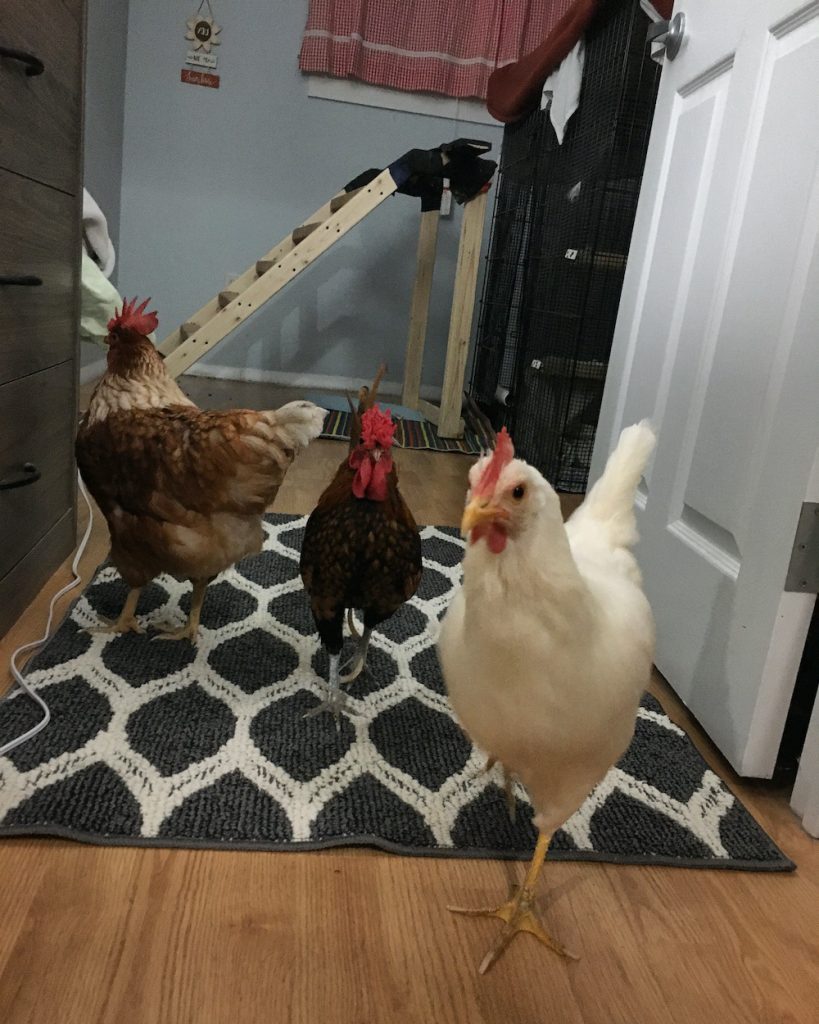
Depending on your setup, it may be best to designate a specific space for the chickens to stay in when not supervised. Giving them their own space can make it easier to ensure your chicken companions are in a safe environment and may also make clean-up easier. This space might be a completely separate room or just a sectioned-off space, but it should be set up to meet the specific needs of your chicken companions. When someone is around to supervise, you may decide to let the chickens have access to other areas of the home as long as these areas are safe.
Safe Flooring
This will be most important with bigger breeds of chickens (especially large breed chickens, like Cornish crosses), senior birds, and those with mobility issues, but it’s important to consider flooring whenever a chicken is living in the house. Some types of flooring may be too slippery, such as smooth linoleum or ceramic tile, and could result in injury. Also, keep in mind that many types of flooring are hard and may put undue strain on a chicken’s feet and joints.
If you have created a separate space for your chicken companions, you should take steps to ensure that this flooring is not only non-slip, but also provides some sort of cushion – this is important for many chickens, but is imperative for large breedDomesticated animal breeds that have been selectively bred by humans to grow as large as possible, as quickly as possible, to the detriment of their health. chickens (who are already more prone to arthritis and bumblefoot) and chickens with arthritis or other mobility issues. Yoga mats or children’s play mats may be a good base layer, and the addition of soft blankets (avoid loosely woven or knitted blankets, as chickens can get their nails caught in them) or dog beds can also help- just make sure there isn’t so much cushion that it becomes difficult for the chickens to walk!
When chickens are spending time in other areas of the home, be sure to consider whether or not the flooring is safe. This is especially important for senior chickens, someone with foot, leg, or joint issues, and bigger breeds (including large breed chickens). If there are any elevated spaces the chickens have access to (even small elevations), be sure to consider the surrounding flooring and ensure it isn’t slippery or too hard. If a chicken has a favorite place they like to hop on, find a way to create a safe way for them to get down. Perhaps you can offer carpeted steps (like those designed for dogs) so they can hop down one step at a time, or you might add an object that creates a landing platform partway down (perhaps a chair or ottoman- just make sure these provide appropriate traction). Alternatively (or additionally), you might want to add more cushion to the area where they are most likely to hop down- perhaps a dog bed, large pillow, or thick rug.
If your home has stairs, be sure to consider whether or not these are safe for your chicken companion to have access to. Stairs can be a fun and interesting element, but for some individuals, especially those with mobility issues, they may not be safe.
Chicken-Safe Elevated Spaces
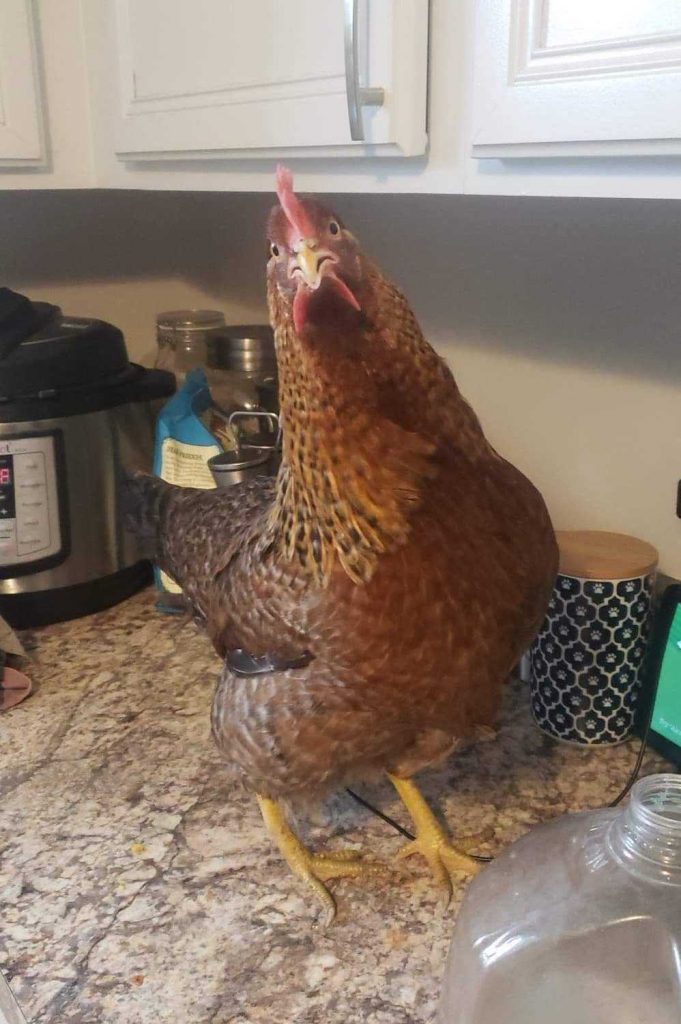
Depending on the breed of chicken(s), you may be living with someone who can fly up onto elevated spaces such as shelves, countertops, or furniture. This is yet another reason why creating a designated chicken space for unsupervised time can be helpful. You can design the space so that it is either free of areas to which they can fly up, or you may purposefully include them, but in a thoughtful way. Chickens are quite inquisitive – you could find a chicken companion up on a shelf full of knick-knacks or fragile items. They could accidentally knock something to the floor, and if it is a breakable item, not only will that be a potential loss for you, it could also create a dangerous situation for the chickens. You don’t want them near broken glass or ceramic, so be sure to take steps to prevent chickens from accessing breakable items.
You should also identify any items that could tip over if a chicken perched on top of them and either ensure your chicken companions can’t access them or find ways to secure them so they can’t tip. For example, if you are using a foldable metal exercise pen to create a separate chicken space, ensure that this will remain stable should someone perch on top of it. It could be quite dangerous if it fell over, especially if there are other chickens in the area.
A Space Free Of Small Items A Chicken Could Ingest

While any chicken could potentially ingest a small item they find in your home (especially if it resembles food), if you care for large breed chickens in your home, you must be particularly vigilant about keeping them away from any item they could ingest, as they have been known to enthusiastically eat anything they can find. There have been reports of large breed chickens ingesting a wide variety of items- for example, magnets, staples, paperclips, thumbtacks pulled from a corkboard, jewelry (sometimes skillfully and painlessly removed from a human companion!), loose change, and even a combination of these things. This means that all small objects should be kept out of reach. If other companion animals are living in the house (especially a cat) or if there are children in your home, you must ensure that they aren’t able to drop, knock, or otherwise put small items within your chicken companions’ reach.
If your large breed chicken companions are out roaming, you must also be careful not to drop small items (and be prepared to quickly retrieve dropped items or restrain your chicken companions should you drop something). You’d be surprised how quickly a large breed chicken can move if they think there is food involved! In addition to the items already listed, we’ve also heard stories of large breed chickens ingesting dropped medications, as well as stories of large breed chickens getting into their own food supply or another companion animal’s stash, so be sure all food is safely stored out of everyone’s reach.
If you care for young large breed chickens, keep in mind that they could be able to get onto elevated spaces mature large breed chickens cannot, so you’ll need to make sure they can’t jump out of their area or jump onto a surface containing items they could ingest.
If You Share Your Home With Other Companion Animals…
Dogs

If you also share your home with a dog, keep in mind that dogs are predators and chickens are prey animals. While there have been dogs and chickens who have gotten along well, this is not a guarantee. As a general rule, we recommend keeping dogs away from chickens – there have been reports of chickens being killed by otherwise gentle dogs. If you have reason to believe your chicken and dog companions are likely to get along, be sure to very closely monitor their interactions. Even if they appear to get along, we recommend only having chickens and dogs in the same space while a caregiverSomeone who provides daily care, specifically for animal residents at an animal sanctuary, shelter, or rescue. is there to supervise and watch for (and respond to) any warning signs.
Keep the chicken’s psychological well-being in mind as well; if the dog’s presence appears to cause the chicken distress, even if you know they aren’t at risk of physical harmThe infliction of mental, emotional, and/or physical pain, suffering, or loss. Harm can occur intentionally or unintentionally and directly or indirectly. Someone can intentionally cause direct harm (e.g., punitively cutting a sheep's skin while shearing them) or unintentionally cause direct harm (e.g., your hand slips while shearing a sheep, causing an accidental wound on their skin). Likewise, someone can intentionally cause indirect harm (e.g., selling socks made from a sanctuary resident's wool and encouraging folks who purchase them to buy more products made from the wool of farmed sheep) or unintentionally cause indirect harm (e.g., selling socks made from a sanctuary resident's wool, which inadvertently perpetuates the idea that it is ok to commodify sheep for their wool)., you must take steps to alleviate the chicken’s stress by giving them a safe space away from the dog.
Cats
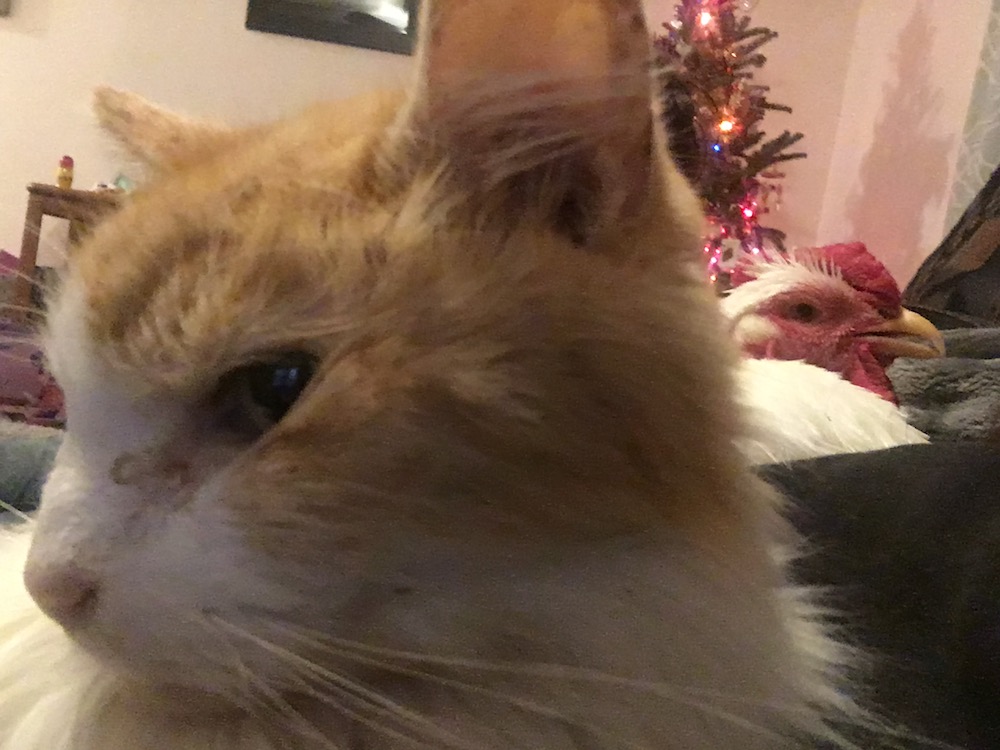
Cats and chickens typically don’t bother each other (and may enjoy each other’s company). However, it’s important to keep in mind that cat saliva is highly toxic to birds and any occasion, albeit rare, where a cat grabs a chicken with their mouth requires immediate veterinary guidance. Your veterinarian may decide to put the chicken on a round of antibiotics to protect them from any potential infection that might have been caused/ introduced by the bacteria in the cat’s saliva. Another area of concern is chicks, who should absolutely be kept away from cats. Chicks are extremely vulnerable, and there have been multiple reports of chicks being killed by cats. As with all introductions and living arrangements, when housing chickens in the same area as cats, be sure to monitor everyone’s behavior closely and make changes as needed. Also keep in mind that kittens, while maybe not a danger, could be a nuisance to a chicken if they are constantly trying to play!
When housing chickens with cats, be sure to set up the space so that the cat’s litter box is in an area where the chickens cannot access it. Not only will chickens likely turn the litter box into a dust box, but chickens have also been known to ingest litter, which can cause serious cropA crop is a pouched enlargement of the esophagus of many birds that serves as a receptacle for food and for its preliminary maceration. impactions.
Feeding Arrangements
Be sure to consider feeding arrangements. A dog or cat who is otherwise happy to be around chickens may not appreciate chickens encroaching their personal space while they are eating. With dogs especially, this could have devastating consequences. If you care for large breed chickens, you’ll absolutely need to keep them separated during other companion animal’s feeding time to ensure they don’t sneak a bite (or, more likely, many, many bites).
Houseplants
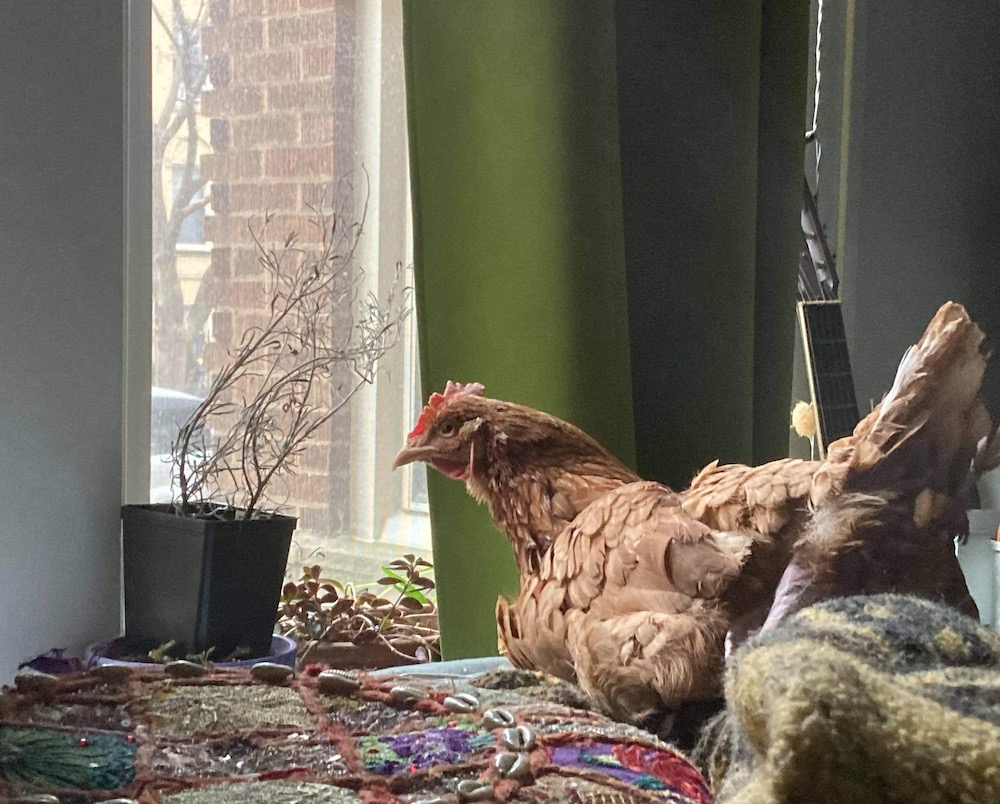
Just as you must ensure that outdoor spaces are free of potentially toxic vegetations, you must also consider whether or not any houseplants you have are safe for chickens to be around. Also, consider any fertilizer or treatments used on the plant or soil and keep chickens away from anything potentially toxic.
Another thing to keep in mind with houseplants is that it is very likely someone will decide to try and take a dust bath in the pot if they can reach it and can fit in it. Some folks don’t mind their chickens doing this and simply clean up the subsequent mess. However, you’ll want to ensure that the plant and pot won’t tip when someone tries to jump up into the pot, and as mentioned above, you’ll need to make sure the dirt is free of any toxic substances.
Consider Their Respiratory Health
A chicken’s respiratory system is quite different and much more efficient than that of a mammal, and they are very sensitive to inhaled toxins and irritants. In a coop setting, there are a variety of things a chicken caregiver must keep in mind in order to protect their residents’ respiratory health, and the same is true in a home setting. One of the most important things to keep in mind is that polytetrafluoroethylene (PTFE) is toxic to birds when inhaled. At high temperatures, items containing PTFE can put out highly toxic fumes, causing Polytetrafluoroethylene Toxicosis (also known as Teflon Flu and Polymer Fume Fever). In a home setting, there are a variety of items that could contain PTFE, including:
- Teflon-coated cookware
- Self-cleaning ovens
- Ironing board covers
- Waterproof or stain-resistant fabrics
- Computer wires
- Space heaters
- Heating pads
- Hairdryers
- Some orthopedic footwear
- Some medical devices
Never use cookware coated with Teflon if you share your home with birds. We suggest you identify items in your home that contain PTFE, especially those that are used with heat, and replace them with safer alternatives. If you are unsure if a product is safe, especially one that is used with or produces heat, contact the manufacturer.
Other household items that could cause issues when vapors are inhaled by birds include cleaners containing ammonia, bleach, and aerosol products. Birds also should not be around smoke. To play it safe, it’s best to keep birds away from fumes and heavily scented products. If you have plans to paint or do renovations, you’ll need to identify a safe space for your chicken companions to go where they won’t be exposed to paint fumes or lots of (potentially toxic) dust. There are low and zero VOC paint options available, and if you’re taking on a painting project in any home with birds, it is worth checking into these options to make sure that your environment is as safe as possible.
Opportunities To Exhibit Natural Chicken Behaviors
Whether in a coop or your home, chickens need opportunities to be chickens. While you may assume that these opportunities are an intrinsic part of a coop setting and are more difficult to provide in a home setting, that’s not actually true. While many people tend to imagine chickens in coops, this setting is no more natural to a chicken than a house. To ensure you are creating living spaces and arrangements that allow chickens to be chickens (whether in a coop or your home), it’s important to think about who chickens are, as well as what they need and what they want.
Social Needs
While some chickens may do just fine as the only chicken living alongside their human caregiver(s), it’s important to keep in mind that chickens are social animals who typically live in flocks with other chickens when given the opportunity. If you are home the vast majority of the time, a chicken who is bonded with you and able to spend lots of time with you may be content living without other companions. However, if you are gone regularly, a chicken living without other companions could become lonely, bored, or stressed and will likely benefit from the companionship of another chicken (or multiple chickens) or a companion of another species with whom they are safe to spend time unsupervised. Each individual is different, so you’ll want to observe them and get to know them so you are best able to determine the right social arrangement for them.
Outside Time
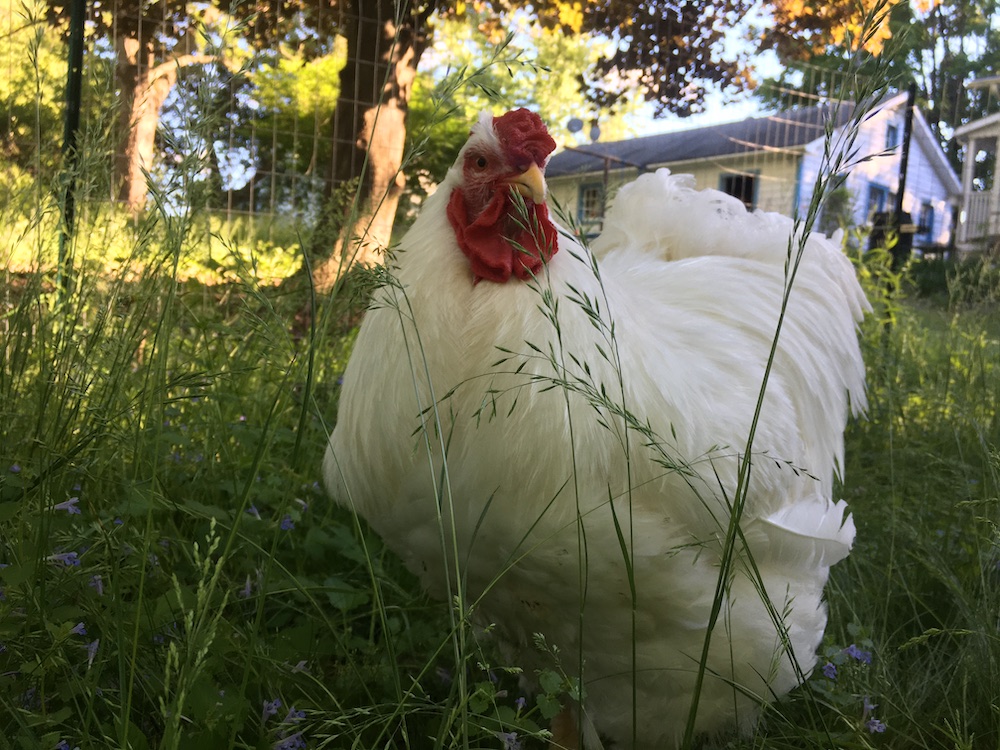
When the weather is pleasant, most chickens will enjoy some time outdoors. What this looks like will depend on your setup and also the individual(s) in your care. Chickens are vulnerable to predation from both terrestrial and aerial predators. It’s important to learn about the potential predators in your area so you can enact measures to keep them protected. (And if you think there are no predators to chickens in your area, think again!) Predators to chickens include dogs, foxes, raccoons, weasels, and raptors, just to name a few.
Some caregivers only provide supervised outdoor time for their chicken companions, others have setups that offer enough protection that they feel comfortable providing outdoor time during periods when all the humans are away from home (such as during the workday), and some caregivers offer unsupervised time outside, but only when they are home and able to check in on the chickens often and are likely to hear any disturbances. It’s important to note that even if you only provide outdoor time for your chicken residents when you are supervising, your presence, while possibly a deterrent for some predators, is not the same as a physical barrier of protection. A loose dog or swooping hawk can strike at alarming speeds. If you are considering providing outside time while all humans are away from home, keep in mind that predation is not the only concern to consider. Weather can be unpredictable, other humans may not have the kindest intentions, and random accidents can happen. Whenever possible, it’s much safer for your chicken companions to be indoors if no one is around to respond immediately to situations that arise.
While some caregivers may install fencing to create safe outdoor spaces for their chicken residents, another option is to use dog kennel kits which can be installed without the need for fencing equipment. Kennel panels come in varying sizes, and pens can be reconfigured and moved as needed, so these can be a great option for folks who are starting out and aren’t sure how big of a space they need and are also great for folks who are renting or planning to move in the not-too-distant future. Many of these kennel kits come with a solid fabric covering for the roof, but this can be replaced with aviary netting to offer protection while also bringing in sunlight. Most welded wire designs have rectangular openings that are about 2 inches by 4 inches, and they also have a small gap at the bottom, which could allow certain predators to enter the space or reach into the space. Depending on your setup and the amount of supervision your chicken companions will have, covering these gaps with fencing material that has smaller openings (at least up to a certain height) may be necessary. Concrete blocks around the perimeter may also be an option. Chickens should be moved into your home (or a predator-proof coop) before dusk to protect against nocturnal predators.
Once you’ve created the perimeter for your chicken companions’ outdoor space, be sure to think about what the space itself should include (and not include). Though many people picture chickens living in open pastures, they are descendants of red junglefowl who, as their name suggests, live in the jungle. Keep this in mind when designing their outdoor space. Covered spaces will offer a sense of protection as well as shade, and for individuals who enjoy elevated spaces, see if you can add some interesting perching opportunities. If you’d like to read more about habitat design and check out pictures of different living spaces, check out Creating A Good Home For Chickens and Breaking The Mold: How Animal-Centered Design Can Transform Sanctuaries.
Be sure to learn about toxic plants in your area and ensure your chicken companions do not have access to these in their space. Check out our Global Toxic Plant Database here. Also, keep in mind that chickens should not have access to grass that has been treated with chemicals.
Be Careful With Extreme Temperature Fluctuations
When a chicken is living in the house, they will become acclimated to the indoor temperature and may not do well going outdoors during cooler weather. Not only might they be a bit more sensitive to the cold than a chicken living in a coop, but they also could become sick from the extreme change in temperature. Be sure to consider both the weather and the difference in temperature before moving chickens outdoors.
Dust Bathing
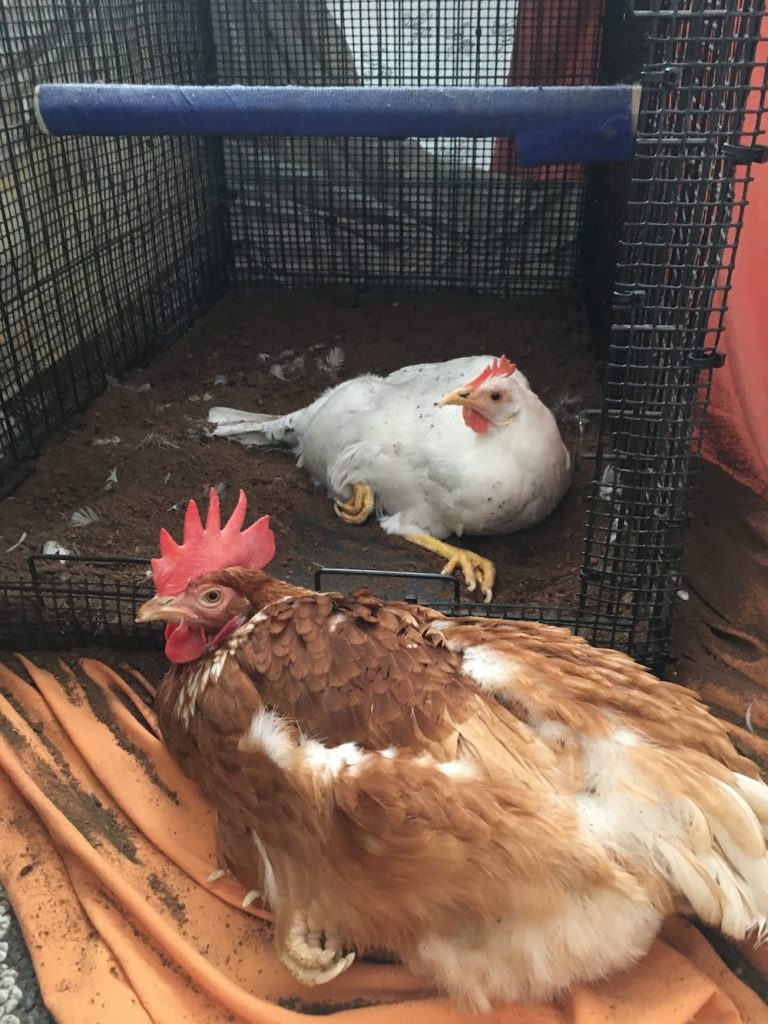
Be sure to offer chickens a place to dust bathe, as this is a natural behavior and one that helps keep them healthy by helping to prevent external parasites. Their outdoor space may naturally provide spaces to dust bathe, but depending on your soil type, you may need to offer loosened dirt for dust bathing. You can dig out a section of ground and fill it with loosened dirt or you can provide it in an easily accessible container, such as a large litter box, shallow sandbox, kiddie pool, or something custom built- just be sure it’s something your chicken residents can safely get in and out of. It may be helpful to use something that can be covered to keep the contents dry.
Some people have found ways to offer a dust box indoors, but be aware that this can create quite a dusty environment and can lead to poor air quality, so you’ll need to ensure that you are keeping this space cleaned regularly. Adding indoor air filters can also be helpful. While indoors, you will likely find that your chicken companions will simulate dust bathing on soft blankets or other materials. Just remember to provide blankets that are safe from nails being caught, such as fleece blankets. Loose knit blankets can easily get caught up on enthusiastic feet. Because external parasites tend to be less of an issue in a home setting, simulated dust bathing may be enough to meet their psychological needs, but if parasites are an issue, simulated dust bathing will not offer the same benefits as a real dust bath.
Nesting Areas For Actively Laying Hens
Actively laying hens will need nesting areas, and there are a variety of ways to provide these. Some options include a large rubber tote, placed on its side and filled with soft bedding; a padded dog or cat carrier; a large cat “cave” filled with soft bedding, or a custom-built piece. Anything that creates a cozy nook but is also easy for chickens to get in and out of could be used for a nesting area- just be sure it can be cleaned fairly easily.
Sleeping Accommodations
A house chicken may soon realize they are safe from predators, so may not mind sleeping at ground level, but others may still prefer to perch or sleep on an elevated space overnight. You can get creative with perching options- just make sure it is sturdy, at an appropriate height based on the size and health of the chicken, and that the flooring surrounding it will make for a safe landing when the chicken comes down in the morning. Some caregivers create contained sleeping areas for their chicken companions, such as a dog kennel, crate, or playpen (and these can even be outfitted with a perch), while other caregivers prefer to let their chicken companions have free roam of a specific room or area of the house. Whatever you decide, keep the following in mind:
- Consider if your chicken companions are likely going to wake up before you and whether there are any safety concerns in the area if they do. This may impact whether or not you would rather have them in a contained space overnight.
- For chickens who don’t perch overnight, be sure to offer them a soft, cushioned spot to sleep. This is especially important for large breed chickens and individuals with arthritis. A thick dog bed can be covered with a blanket for easy cleanup or you can simply fold thick blankets to create a nice cushioned area for them to sleep.
- If you are caring for a rooster and are trying to somewhat delay their first-morning crowing session, you’ll want to block out as much light as possible. Many rooster caregivers say that they get used to the early morning crowing over time, but if you aren’t one of those people, you could set up their sleeping space away from where you sleep and can install some sound-proofing panels or sound-absorbing fabrics (even just adding rugs, curtains, towels, and upholstered furniture can make a difference). Similarly, if you are dealing with noise complaints, be strategic about where your rooster companion sleeps. A sleeping area in your basement or in a room that is furthest away from neighbors can make a difference, especially if you are also adding some sound-proofing or sound-absorbing materials.
Indoor Enrichment
Projected images can be a great form of visual enrichment, but in Helen’s case, she prefers to BE the projected image. Photo: Kelsey Atkinson Cantaloupe likes to get as close as possible when Luke plays guitar. Oliver and Lilith bask in a ray of sunlight, which is a favorite of most chickens. Photo: Ashley Snyder Oliver enjoys his happy light on a winter day. Photo: Ashley Snyder
Here at The Open Sanctuary Project, we encourage folks to consider enrichment an aspect of basic care rather than something optional. Enrichment is an important aspect of chicken care regardless of whether or not your residents live in their own coop or inside your home. However, the types of enrichment provided may be a bit different depending on the individual’s living arrangement. For example, as we alluded to above, because dust bathing is a natural chicken behavior, it’s important to offer opportunities for chickens to partake in this behavior if they wish. However, depending on your setup, regularly offering actual dirt indoors may not be practical, in which case offering soft fabrics for them to simulate dust bathing may be a reasonable substitute. Below we’ll highlight some popular enrichment for house chickens (you’ll also want to consider enrichment when creating their outdoor spaces). You can read more about enrichment for chickens here.
- Vitamin D Lights– Some people find that using Vitamin D lights, or “Happy” lights, during the winter can be beneficial for chickens living in a home setting, but be aware that these lights can affect egg-laying. It is best if they are used in a way that mimics the natural cycle of light and darkness for the time of year, so we recommend they are only used during daylight hours and that chickens still have access to periods of darkness.
- Utilize Windows– If it’s possible, set up a safe way for house chickens to view the outdoors through a window or door, which may be both mentally stimulating and (depending on where you live) may also give them the chance to enjoy some sunshine (chickens love to sunbathe!).
- Bring The Outdoors In– When chickens are unable to go outside, bringing in natural elements can be a great form of enrichment. At Chicken Run Rescue, soft-sided playpens are partially filled with dried leaves (which they stock up on and save for continued enrichment). They also sprout grasses for munching on and grow grass in flats that can be used as both an enriching substrate or a treat. Sprouting seeds and beans is also another way to offer your indoor companion a little fresh plant life to enjoy!
- Schedule A Little Screen Time– Put on a nature show, webcam, or cartoon to offer both visual and auditory enrichment. Avoid nature shows/ webcams that include predators so as not to cause distress. By watching your residents’ reactions to the shows you offer, you’ll be able to determine which they prefer and which should be avoided.
- Play Music Or Nature Sounds- Again, be thoughtful about what music or sounds to play. Bird recordings that include predator alarm calls will cause a ruckus. As above, be sure to watch your residents’ reactions to determine which recordings they prefer. If you play an instrument, you may find your chicken friends enjoy being serenaded!
Keeping Your Home (And Their Home) Clean
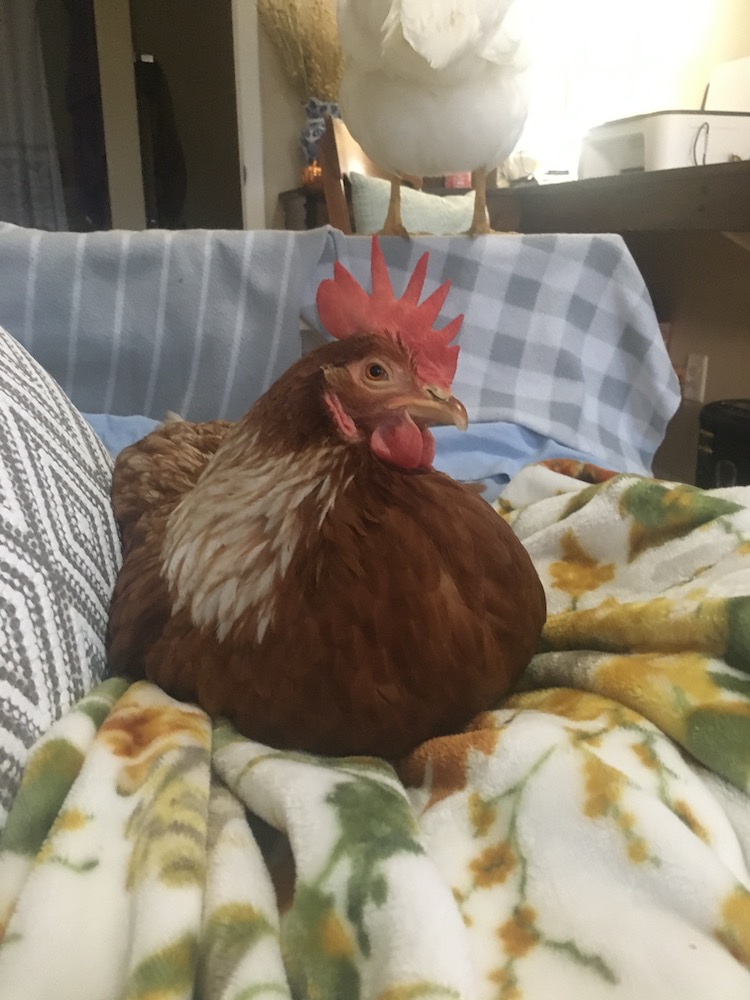
When folks first learn that some chickens live indoors with their human companions, their first question is usually something like, “But what about all that poop!?” It’s true that chickens poop a lot and litter box training for chickens isn’t exactly a thing, but it’s probably easier than you may think to keep things clean. That said, you should still be prepared to do lots of cleaning, but this is true whether chickens live indoors with you or in their own coop. An added bonus of housing chickens indoors is that daily cleaning projects don’t require venturing out into the cold!
Most chicken poop is well-formed, making cleanup of most surfaces fairly easy so long as you regularly pick up poop throughout the day. The one exception here is cecal poop, which is softer (and therefore, messier) than other chicken stool. If chickens have their own designated space, you can set it up in a way that allows for easy cleanup. Some folks prefer to use fabrics as bedding, while others may opt for the same bedding one might use in a coop. Some bedding options to consider include layered blankets, dog pee pads, diaper changing pads, hemp bedding, or aspen wood shavings (which tend to have less dust than pine). The bedding you choose will need to be cleaned regularly, with fabrics requiring regular laundering and hemp/ aspen bedding requiring regular disposal.
When chickens are out roaming around your house, throw rugs, pee pads, sheets, or blankets (so long as they provide proper traction) can be used to protect surfaces you don’t want pooped on or that may be difficult to clean. For example, you might cover large area rugs or wall-to-wall carpet with smaller throw rugs or blankets that are easier to clean, and if your chicken companions like to spend time on the couch, you may want to keep this covered as well. When chickens have chosen a spot to relax, it can be fairly easy to slip a pee pad, folded blanket, or something similar behind their bum (or in the case of a perching chicken, on the ground below them) to act as a poop catcher.
Diapers
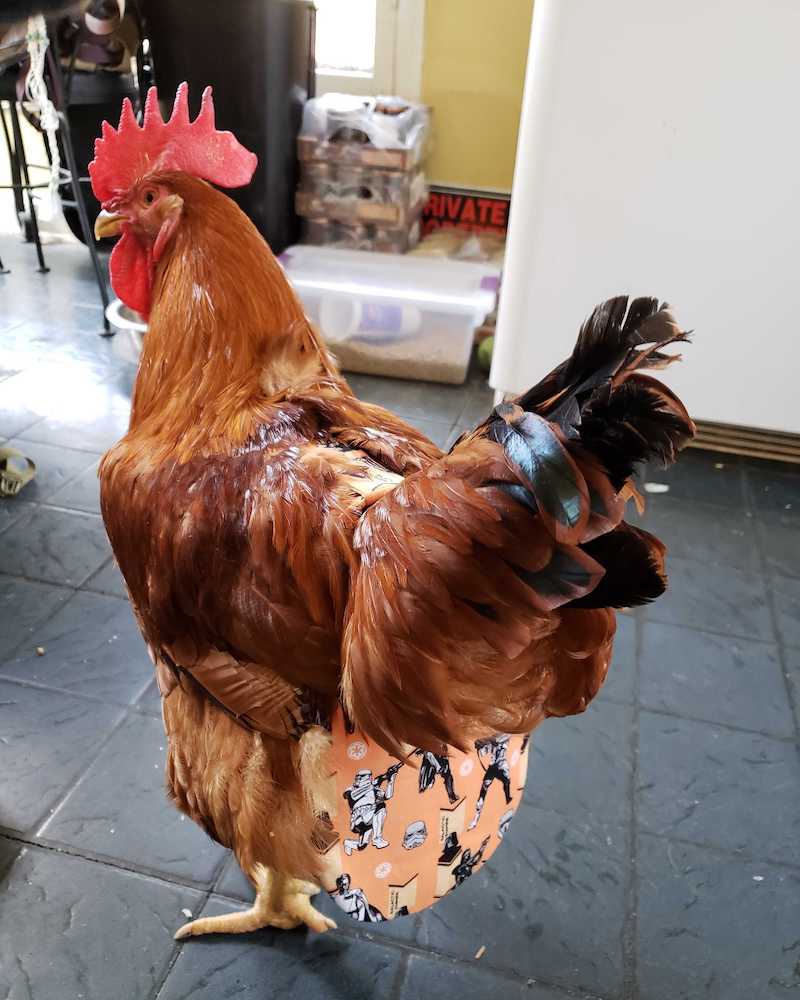
Some people choose to use chicken diapers, but these cannot be used 24 hours a day, so you’ll still need a plan to deal with poop cleanup. If you choose to use diapers, be sure to give the chicken a good amount of time to live diaper-free, and do not keep them in the diaper overnight. If your chicken companions don’t sleep in a designated chicken space set up for easy cleaning, it’s still pretty simple to create a cleanable sleep space by putting down some pee pads or blankets in the area where they sleep or under their perching spot (one thing to keep in mind with perches is that if they are close to a wall, the wall may end up covered in poop). Consider reserving diapers for times when the chicken is actively roaming outside of their designated space or are in an area that is difficult to set up for easy cleaning.
Diapers will need to be emptied regularly and cleaned (and if you care for a hen, you’ll need to watch closely for signs she is going to lay an egg- or has laid an egg- so you can remove the diaper). One challenge with a diaper is that their poop is concealed, making it more difficult to know when there is poop that needs to be cleaned up. You’ll also need to watch carefully to make sure the chicken is comfortable in the diaper- backward walking, standing in an awkward position, or laying down and refusing to move after the diaper is attached are signs the diaper is causing an issue. Be sure to watch for any irritation from the diaper, especially in front of the wings. Depending on the design, it may be helpful to cover straps with a soft material to help prevent irritation. If you find that the diaper is causing irritation or that the chicken has developed a sore, discontinue use until the area is healed, and if you still want to pursue diapers, either try a different design or make alterations to the current diaper to prevent recurring issues. Also be aware that most designs cover the preen glanda large gland that occurs in most birds, opens dorsally at the base of the tail feathers, and usually secretes an oily fluid which the bird uses in preening their feathers (also known as an oil gland or uropygial gland) (found on the chicken’s back, near the base of their tail), which is another reason why the chicken will need a good amount of time out of the diaper- you don’t want to interfere with their ability to preen. You may find that the feathers around their vent get a bit dirty, in which case you will have to clean them regularly. Warm water and paper towels usually do the trick nicely!
Air Quality
Depending on your setup and how many chickens are living in your home, you may find that your home’s air quality is affected. Many people find it helpful to use one or more air filters to maintain healthy air quality for all residents, both human and non.
It’s a good idea to look at your setup to see if there are changes you can make to reduce dust, such as switching from pine wood shavings to aspen (which are typically lower dust) or switching from aspen shavings to hemp bedding to further reduce dust. Be sure to keep all bedding clean and dry to prevent ammonia buildup. As we mentioned above, indoor dust bathing can cause quite a mess and affect indoor air quality, so if you provide this, you’ll want to be strategic about when and where and be sure to clean up afterward.
When chickens are molting, you’ll find feathers and the bits of the waxy coating that surrounds new feathers everywhere. There’s not much to do about this other than to vacuum/ clean regularly. This isn’t a more difficult or different issue from that of when more “conventional” companions such as dogs or cats blow coats or shed, and anyone used to living with parrots will also be very accustomed to it.
Consider Microsanctuary: Welcome A Chicken Into Your Home!





Clockwise from top left: Ashley and Oliver (Photo: Ashley Snyder); Leonard Crowen waits for his veggies to cook (Photo: Julia of Chicago Roo Crew); Working from home means more snuggle time for Cantaloupe; Helen and Kelsey (Photo: Kelsey Atkinson); Meli snuggles up to Natalie (Photo: Natalie of Chicago Roo Crew)
Even with all the above considerations and concerns to observe, we urge folks to consider that a chicken is no different from any other indoor animal companion. You will always have to make allowances and take safety precautions to make sure that your friends are safe, no matter what their species. An indoor chicken, as surprising as the concept may seem to some people, can often be easier to care for than some of the other bird species who are more commonly thought of as companion animals. Chickens enjoy their human companions, generally, and adapt well and readily to indoor circumstances. Can you imagine a better afternoon than snuggling next to a fluffy friend on a fleecy blanket? With the proper precautions and care, you can easily welcome a chicken friend into your home and enjoy moments such as these.
In sharing your home with chickens, you will have a unique opportunity to learn closely and personally how delightful these feathered friends are, how much personality they have, and how fun life with them can be. Caring for an indoor chicken or two also will give you a unique opportunity to learn about and share your friends’ personalities and stories on a very intimate level, and as a bonus, you can be a part of the growing microsanctuary movement, which seeks to normalize living with farmed animalsA species or specific breed of animal that is raised by humans for the use of their bodies or what comes from their bodies., such as chickens, as companions. There are increasingly more resources and support available for microsanctuariesMicrosanctuaries are small scale communities of human and nonhuman (generally “unconventional or farmed”) animal companions, who live together in a chosen shared lifestyle and in commitment to ending the oppression of all beings. Microsanctuaries adhere to the notion that no nonhuman member of the community should “serve a purpose.” Microsanctuaries can exist in any context: rural, suburban, or urban. A microsanctuary can consist of as small a community as one animal and one human caregiver. For more information on microsanctuary please refer to the Microsanctuary Resource Center., and in turn, the larger the number of microsanctuaries dedicated to compassionate care there are, the more wonderful homes are available to these birds!
Article Acknowledgements
This resource could not have been created without the countless caregivers who have welcomed chicken companions into their homes and then shared their experiences, insights, and lessons learned with other folks who are setting out to do the same. The shared knowledge of this community is vast. In particular, Chicken Run Rescue and Penelope’s Place were instrumental in the creation of this resource.
Download The Free Printable Indoor Chicken Brochure!
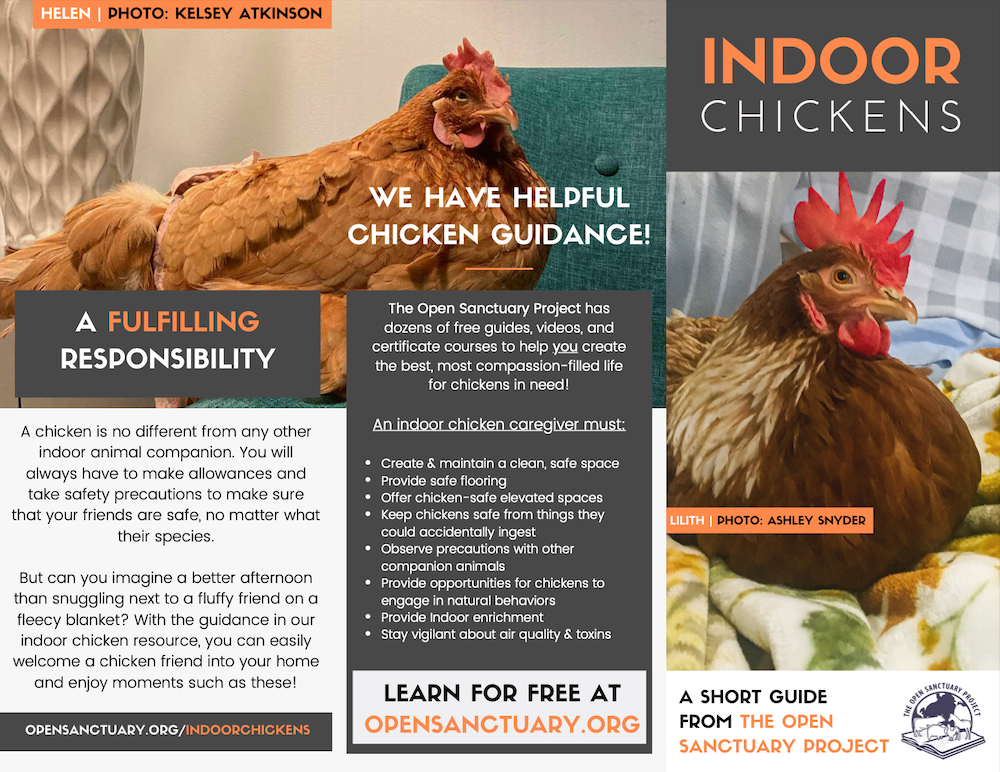
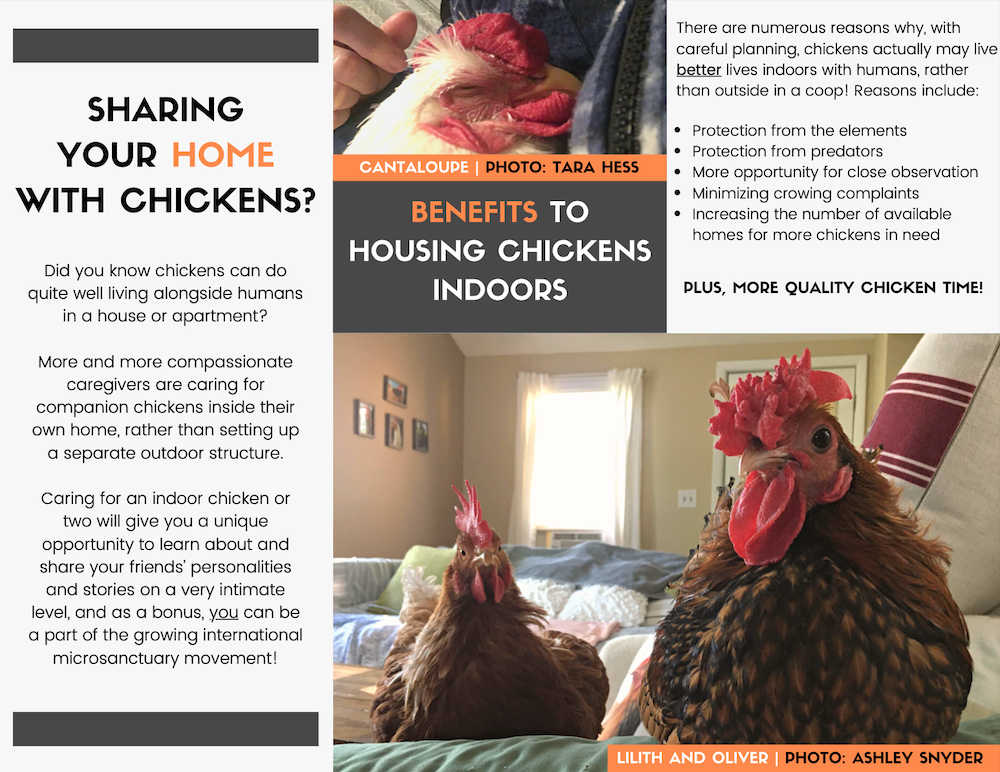
We’ve developed a free, printable brochure to help educate visitors and the folks in your life about indoor chickens! You can download and print it here!
SOURCES:




